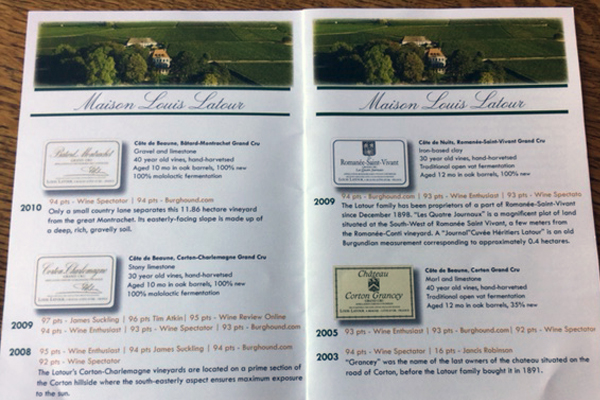Over the years the wines of Montrachet have been considered the best and generally are the most expensive of all white Burgundy. It is certainly exclusive with 8 hectares producing only about 3,410 cases per year – or less in frost damaged ones like 2016. Roughly half is in Puligny & half in Chassagne where it is often called “Le Montrachet” – though Bouchard Pere has their vineyard signpost in Puligny marked “Le Montrachet”. There are 17 owners led by Marquis de Laguiche (2.06 hectares) marketed by Joseph Drouhin and Baron Thenard (1.83) marketed by Remoissenet. It is one of the 5 Grand Cru Montrachet-designated vineyards together with Chevalier, Batard, Bienvenue-Batard, and Criots-Batard. The reputation of Montrachet is for the intense rich full character of Batard combined with the elegance of Chevalier into something really special much more concentrated, complex, and age worthy. Certainly that outstanding quality has shown up in many spectacular bottles experienced by your scribe over the years including several Domaine de la Romanee-Conti (especially the legendary 1973 and youthful 2010) and a Balthazar (12 litre/16 bottle format) of Ramonet 1986 at a dinner of pan seared lobster with fresh white truffles in Miami on November 2, 1997. Those amazing terroir aromatics plus balanced power and finesse with a touch of spice were so memorable. However this century have often found Montrachet to be a little too heavy for my delicate palate. I have been collecting and enjoying to drink more of the reasonably priced “lighter” elegant mineral (what causes that?) focused wines of Chevalier, Meursault Perrieres, Corton-Charlemagne, and Grand Cru Chablis – especially Les Clos! Not sure climate change plus the current style trend for white wine appreciation is helping the Montrachet old benchmark. Sorry – just raising the question? A lot of these thoughts came back to me at a dinner-tasting last week featuring six interesting Montrachet wines:
2006 REMOISSENET BARON THENARD: Darkest of first flight. Mature bouquet showing some oak with full textures. A touch coarser and ready for drinking. Heavy.
2004 JOSEPH DROUHIN MARQUIS DE LAGUICHE: Youngest youthful colour. Toasty but lovely fragrant complex nose. Big rich concentrated balanced flavours impress.
2000 OLIVIER LEFLAIVE: Deep yellow look. Tad musty cellar notes with bold spices. Structured but this bottle not clean enough. Disappoints.
1988 LOUIS LATOUR 13.4: Lighter fresher style of these 3 vintages. More towards Chevalier elegance. Improved in the glass and opened up nicely. Delicious.
1986 LOUIS LATOUR 13.2: Looks vibrant and deep. Perfect rich creamy intensity. Like the style with no botrytis here but sometimes appears in 1986. Very textbook.
1985 LOUIS LATOUR 13.6: All were decanted and then poured immediately. The hazy tartaric crystals thrown had been allowed to settle to the punt with the bottles standing up for a few days resulting in very clear bright pours. Note the admirable lower alcohols here compared with the now more commonly seen 14+ range. Unfortunately this riper year is a little too mature with sherry elements. Still very rich and so Montrachet for the ris de veau course. Fond memories of our long debates at the IWFS Wines Committee meetings that included both Clive Coates & John Avery on the long aging abilities of 1986 vs. 1985 white Burgundy. 1986 won here. Other times 1985 has been better. 1985 was an excellent red Burgundy vintage (while 1986 was not) but both years made fine whites.
Not too shabby a Vosne-Romanee red wine flight either of all 1995 including the mystery wine of Richebourg from Domaine Gros. Surprised that the RSV was quite a bit darker shades of red depth than RC but the latter has the much more sensational profile for sure but still needs more time to reach that top plateau.
Your thoughts please on the style of white Burgundy that you enjoy the most.
You might also like:
 |
 |
 |

